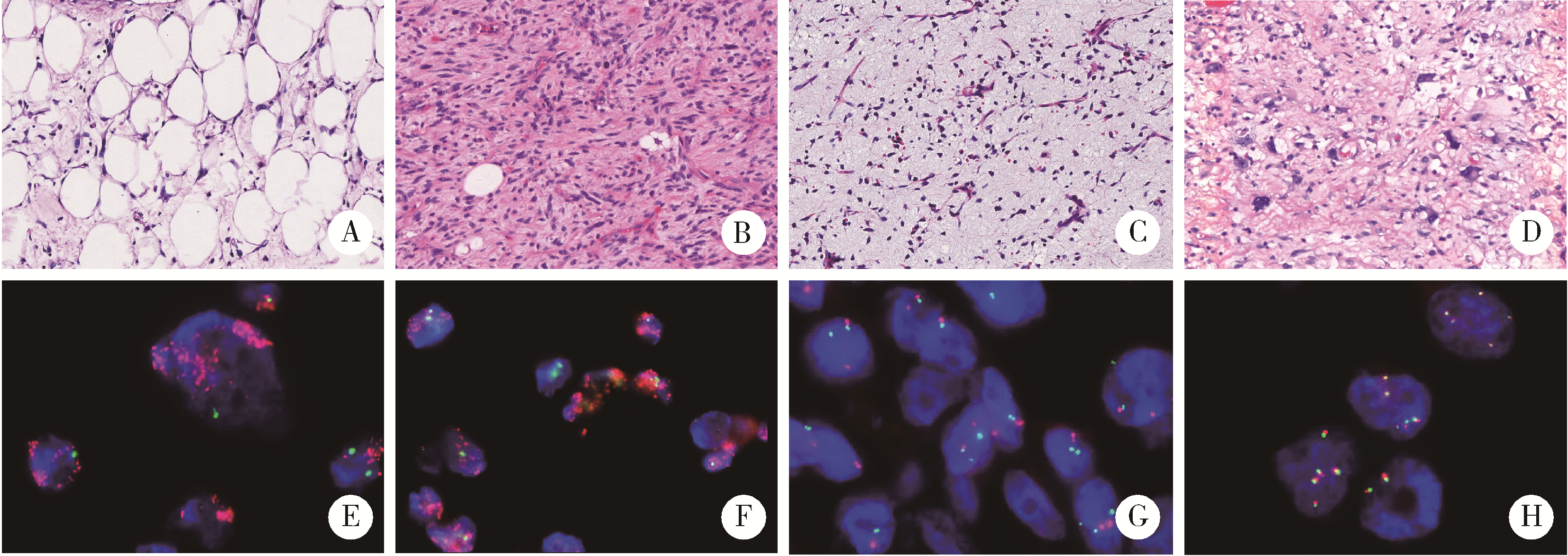北京大学学报(医学版) ›› 2023, Vol. 55 ›› Issue (2): 228-233. doi: 10.19723/j.issn.1671-167X.2023.02.005
荧光原位杂交检测MDM2和DDIT3基因信号改变在诊断脂肪肉瘤中的价值
- 北京大学第一医院病理科,北京 100034
Clinical value of fluorescence in situ hybridization with MDM2 and DDIT3 probe in diagnosis of liposarcoma
Wei WANG,Xin LI,Ping LIU,Ying DONG*( )
)
- Department of Pathology, Peking University First Hospital, Beijing 100034, China
摘要:
目的: 探讨荧光原位杂交(fluorescence in situ hybridization,FISH)法检测MDM2和DDIT3基因在各亚型脂肪肉瘤的临床诊断价值。方法: 回顾性分析北京大学第一医院病理科2015年1月至2019年12月诊断的62例脂肪肉瘤的临床病理学特征,所有病例进行了MDM2基因扩增FISH检测,其中48例进行了DDIT3基因断裂FISH检测,观察MDM2和DDIT3基因信号改变模式,并综合临床病理学特征确诊不同亚型脂肪肉瘤。结果: 62例患者以男性多见(男: 女=1.75:1),中位年龄59(31~89)岁。脂肪肉瘤组织学亚型包括20例非典型脂肪瘤性肿瘤/高分化脂肪肉瘤(atypical lipomatous tumour/well differentiated liposarcoma,ALT/WDLPS)、26例去分化脂肪肉瘤(dedifferentiated liposarcoma, DDLPS)、13例黏液样脂肪肉瘤(myxoid liposarcoma, MLPS)和3例多形性脂肪肉瘤(pleomorphic liposarcoma, PLPS),其中23例(23/26)DDLPS和8例(8/20)WDLPS位于腹膜后,而MLPS和PLPS则均不位于腹膜后。肿瘤发生部位在不同亚型脂肪肉瘤间的差异具有统计学意义(P < 0.05)。组织形态学上,各亚型脂肪肉瘤均可见多少不等的黏液样间质,且差别具有统计学意义(P < 0.05)。MDM2基因扩增见于所有ALT/WDLPS和DDLPS(均为100%,20/20及26/26);DDIT3分离探针典型信号表现为基因断裂/易位,仅见于MLPS(100%,13/13),但值得注意的是,该探针还可出现非典型信号(端粒侧信号簇状扩增),比较常见,包括绝大多数DDLPS(96.2%, 25/26)和ALT/WDLPS(83.3%,5/6,探针只随机检测6例)。对照分析探针说明书上的设计图,DDIT3分离探针之红绿色探针并未覆盖DDIT3基因本身,而是跨越了DDIT3基因,且探针端粒侧红色探针覆盖了CDK4基因,而DDIT3基因与CDK4基因距离很近,因此,当DDIT3分离探针端粒侧出现簇状扩增信号,提示CDK4基因扩增而非DDIT3基因断裂。随机挑选10例出现这种非典型信号的病例,以FISH法进一步应用CDK4和DDIT3计数探针进行验证,证实为CDK4基因扩增(100%,10/10),其中2例同时检测到DDIT3基因扩增(20%,2/10);DDIT3分离探针还存在另一种少见的非典型信号,即基因拷贝数增加(黄色融合信号数目≥3个),对应形态学表现为多形性和预后差,见于1例DDLPS和2例PLPS。结论: 利用FISH技术观察MDM2和DDIT3基因信号改变模式时, 需要注意对非典型信号做出正确判读,并结合患者的临床病理学特征,才能对不同亚型脂肪肉瘤做出正确诊断,进一步指导临床治疗。
中图分类号:
- R365
| 1 | WHO Classification of Tumours Editorial Board . WHO classification of tumours of soft tissue and bone[M]. 5th ed Lyon, France: IARC Press, 2020: 34- 46. |
| 2 | Nishio J . Contributions of cytogenetics and molecular cytogenetics to the diagnosis of adipocytic tumors[J]. J Biomed Biotechnol, 2011, 2011, 524067. |
| 3 |
Weaver J , Rao P , Goldblum JR , et al. Can MDM2 analytical tests performed on core needle biopsy be relied upon to diagnose well-differentiated liposarcoma?[J]. Mod Pathol, 2010, 23 (10): 1301- 1306.
doi: 10.1038/modpathol.2010.106 |
| 4 |
Mantilla JG , Ricciotti RW , Chen EY , et al. Amplifification of DNA damage-inducible transcript 3 (DDIT3) is associated with myxoid liposarcoma-like morphology and homologous lipoblastic differentiation in dedifferentiated liposarcoma[J]. Mod Pathol, 2019, 32 (4): 585- 592.
doi: 10.1038/s41379-018-0171-y |
| 5 |
Kuczkiewicz-Siemion O , Wiśniewski P , Dansonka-Mieszkowska A , et al. The utility of fluorescence in situ hybridization (FISH) in determining DNA damage-inducible transcript 3 (DDIT3) amplification in dedifferentiated liposarcomas-an important diagnostic pitfall[J]. Pathol Res Pract, 2021, 225, 153555.
doi: 10.1016/j.prp.2021.153555 |
| 6 |
Cho J , Lee SE , Choi YL . Diagnostic value of MDM2 and DDIT3 fluorescence in situ hybridization in liposarcoma classification: A single-institution experience[J]. Korean J Pathol, 2012, 46 (2): 115- 122.
doi: 10.4132/KoreanJPathol.2012.46.2.115 |
| 7 |
Vargas AC , Selinger C , Satgunaseelan L , et al. FISH analysis of selected soft tissue tumors: Diagnostic experience in a tertiary center[J]. Asia Pac J Clin Oncol, 2019, 15 (1): 38- 47.
doi: 10.1111/ajco.12980 |
| 8 |
Sugita S , Seki K , Yokozawa K , et al. Analysis of CHOP rearrangement in pleomorphic liposarcomas using fluorescence in situ hybridization[J]. Cancer Sci, 2009, 100 (1): 82- 87.
doi: 10.1111/j.1349-7006.2008.01008.x |
| 9 | Creytens D , van Gorp J , Speel EJ , et al. Characterization of the 12q amplicons in lipomatous soft tissue tumors by multiplex ligation-dependent probe amplification-based copy number analysis[J]. Anticancer Res, 2015, 35 (4): 1835- 1842. |
| 10 |
Demicco EG . Molecular updates in adipocytic neoplasms[J]. Semin Diagn Pathol, 2019, 36 (2): 85- 94.
doi: 10.1053/j.semdp.2019.02.003 |
| 11 | 杨邵敏, 吴若晨, 齐双双, 等. 睾丸旁脂肪肉瘤19例临床病理学特征[J]. 中华病理学杂志, 2022, 51 (1): 17- 22. |
| 12 |
Jauhiainen A , Thomsen C , Strömbom L , et al. Distinct cytoplasmic and nuclear functions of the stress induced protein DDIT3/CHOP/GADD153[J]. PLoS One, 2012, 7 (4): e33208.
doi: 10.1371/journal.pone.0033208 |
| 13 |
Yu JSE , Colborne S , Hughes CS , et al. The FUS-DDIT3 interactome in myxoid liposarcoma[J]. Neoplasia, 2019, 21 (8): 740- 751.
doi: 10.1016/j.neo.2019.05.004 |
| 14 |
Berthold R , Isfort I , Erkut C , et al. Fusion protein-driven IGF-IR/PI3K/AKT signals deregulate Hippo pathway promoting oncogenic cooperation of YAP1 and FUS-DDIT3 in myxoid liposarcoma[J]. Oncogenesis, 2022, 11 (1): 20.
doi: 10.1038/s41389-022-00394-7 |
| 15 |
李锐, 叶胜兵, 赵明, 等. 脂肪肉瘤中DDIT3荧光原位杂交分离探针判读陷阱及其意义分析[J]. 中华病理学杂志, 2022, 51 (3): 230- 233.
doi: 10.3760/cma.j.cn112151-20210609-00426 |
| 16 |
Murshed KA , Abo-Samra H , Ammar A . Well-differentiated liposarcoma of the hypopharynx exhibiting myxoid liposarcoma-like morphology with MDM2 and DDIT3 co-amplification[J]. Head Neck Pathol, 2022, 16 (1): 288- 293.
doi: 10.1007/s12105-021-01341-5 |
| 17 |
Sioletic S , Paola DC , Fletcher CD , et al. Well-differentiated and dedifferentiated liposarcomas with prominent myxoid stroma: Ana-lysis of 56 cases[J]. Histopathology, 2013, 62 (2): 287- 293.
doi: 10.1111/j.1365-2559.2012.04348.x |
| 18 |
Rao UN , Cieply K , Sherer C , et al. Correlation of classic and mole-cular cytogenetic alterations in soft-tissue sarcomas: Analysis of 46 tumors with emphasis on adipocytic tumors and synovial sarcoma[J]. Appl Immunohistochem Mol Morphol, 2017, 25 (3): 168- 177.
doi: 10.1097/PAI.0000000000000294 |
| [1] | 李挺. 建设当代临床病理学科[J]. 北京大学学报(医学版), 2023, 55(2): 197-200. |
| [2] | 周桥. 肿瘤病理学研究的进展和展望[J]. 北京大学学报(医学版), 2023, 55(2): 201-209. |
| [3] | 许云屹,苏征征,郑林茂,张孟尼,谭珺娅,杨亚蓝,张梦鑫,徐苗,陈铌,陈雪芹,周桥. 转录通读环状RNA rt-circ-HS促进低氧诱导因子1α表达和肾癌细胞增殖与侵袭[J]. 北京大学学报(医学版), 2023, 55(2): 217-227. |
| [4] | 李东,邸吉廷,熊焰. 程序性细胞死亡1-配体1在不同免疫组织化学染色方法的一致性比较[J]. 北京大学学报(医学版), 2023, 55(2): 339-342. |
| [5] | 熊焰,张波,聂立功,吴世凯,赵虎,李东,邸吉廷. 胸部SMARCA4缺失性未分化肿瘤的病理诊断与联合免疫检测点抑制剂治疗[J]. 北京大学学报(医学版), 2023, 55(2): 351-356. |
| [6] | 陈志强,王莹,米贤军,陈昂,黄华勇,钟守军,邓文同,刘超凡,徐秀梅,代新珍. 聚羟基丙烯酸和Van-clear替代传统试剂在FISH法检测宫颈hTERC基因中的应用比较[J]. 北京大学学报(医学版), 2016, 48(2): 356-360. |
|
||


